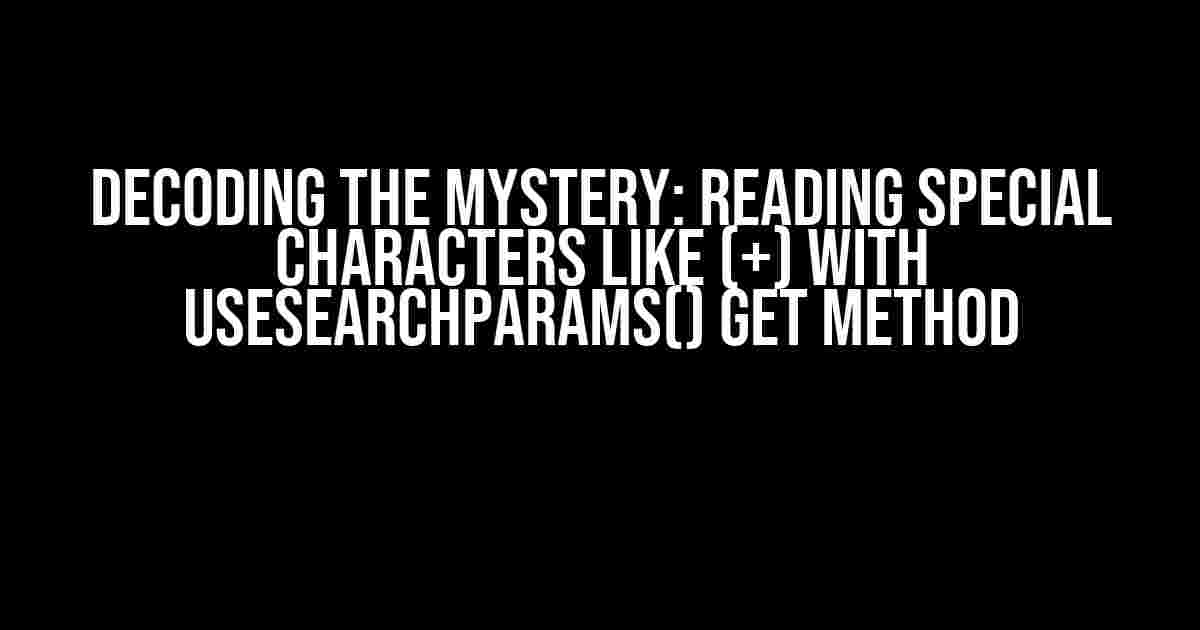Are you stuck trying to read special characters like (+) using the useSearchParams() get method? You’re not alone! It’s a common conundrum that has stumped many a developer. But fear not, dear reader, for we’re about to embark on a thrilling adventure to unravel the mystery of special character encoding and decoding.
- The Problem: + Becomes a Space
- The Reasons Behind the Madness
- The Solution: Encoding and Decoding
- Example: Reading Special Characters with useSearchParams()
- Original Param: {myParam}
- Decoded Param: {decodedParam}
- Common Scenarios and Solutions
- Best Practices for Working with Special Characters
- Conclusion
The Problem: + Becomes a Space
When you try to read a URL parameter containing a special character like (+) using the useSearchParams() get method, it gets decoded to a space. This is because the (+) symbol is a special character in URLs, representing a space.
const params = useSearchParams();
const myParam = params.get("myParam"); // returns "hello world" instead of "hello+world"
The Reasons Behind the Madness
To understand why this is happening, let’s take a step back and examine how URL encoding works:
- URL Encoding**: When a URL is sent over the internet, certain characters need to be encoded to prevent conflicts with the URL syntax. This is done by replacing the special characters with a percentage sign (%) followed by the character’s ASCII code in hexadecimal format.
- Special Characters**: Characters like (+), (&), and (=) have special meanings in URLs. To avoid conflicts, they need to be encoded.
- Decoding**: When the URL is received, the encoded characters need to be decoded back to their original form.
The Solution: Encoding and Decoding
To read special characters like (+) using the useSearchParams() get method, we need to encode the URL parameter before sending the request, and then decode it on the receiving end.
Encoding the URL Parameter
Before sending the request, encode the URL parameter using the encodeURIComponent() method:
const myParam = "hello+world";
const encodedParam = encodeURIComponent(myParam); // returns "hello%2Bworld"
Decoding the URL Parameter
On the receiving end, use the decodeURIComponent() method to decode the URL parameter:
const params = useSearchParams();
const myParam = params.get("myParam");
const decodedParam = decodeURIComponent(myParam); // returns "hello+world"
Example: Reading Special Characters with useSearchParams()
Let’s put it all together in an example:
import { useSearchParams } from 'react-router-dom';
function MyComponent() {
const [searchParams, setSearchParams] = useSearchParams();
const myParam = searchParams.get("myParam");
const decodedParam = decodeURIComponent(myParam);
return (
Original Param: {myParam}
Decoded Param: {decodedParam}
);
}
Common Scenarios and Solutions
In addition to the (+) character, there are other special characters that might cause issues. Here are some common scenarios and solutions:
| Special Character | Encoded Form | Solution |
|---|---|---|
| (+) | %2B | Encode with encodeURIComponent(), decode with decodeURIComponent() |
| (&) | %26 | Encode with encodeURIComponent(), decode with decodeURIComponent() |
| (=) | %3D | Encode with encodeURIComponent(), decode with decodeURIComponent() |
| (space) | %20 | Encode with encodeURIComponent(), decode with decodeURIComponent() |
Best Practices for Working with Special Characters
To avoid common pitfalls when working with special characters, follow these best practices:
- Always encode URL parameters**: Use
encodeURIComponent()to encode URL parameters before sending the request. - Decode URL parameters**: Use
decodeURIComponent()to decode URL parameters on the receiving end. - Use consistent encoding and decoding**: Ensure that encoding and decoding are consistent throughout your application.
- Test thoroughly**: Test your implementation with different special characters to ensure it works as expected.
Conclusion
In conclusion, reading special characters like (+) using the useSearchParams() get method requires careful encoding and decoding. By following the best practices outlined in this article, you’ll be able to decode the mystery of special character encoding and decoding, and ensure seamless communication between your application and the URL.
Remember, with great power comes great responsibility. Use your newfound knowledge wisely, and may the encoded characters be ever in your favor!
Frequently Asked Question
Get answers to the most frequently asked questions about reading special characters like (+) with useSearchParams() get method!
Why can’t I read special characters like (+) with useSearchParams() get method?
The reason is that special characters like (+) are URL-encoded when passed as query parameters. To read them correctly, you need to URL-decode the value before using it. You can use the decodeURIComponent() function in JavaScript to achieve this.
How do I URL-decode the value in JavaScript?
You can use the decodeURIComponent() function in JavaScript to URL-decode the value. For example, if you have a query parameter named “myParam” with a value of “%2B”, you can decode it like this: const decodedValue = decodeURIComponent(useSearchParams().get(“myParam”));
What if I have multiple special characters in my query parameter value?
Don’t worry! The decodeURIComponent() function will take care of decoding all the special characters in the value. Just pass the entire value to the function, and it will return the decoded string.
Can I use useSearchParams() get method without URL-decoding?
Technically, yes, but you’ll get unexpected results. If you don’t URL-decode the value, special characters will be treated as URL-encoded, which can lead to errors or unexpected behavior in your application. So, it’s always best to decode the value to ensure correct interpretation.
Is there a way to avoid URL-encoding special characters in the first place?
While it’s not possible to completely avoid URL-encoding special characters, you can use a different approach to pass data between pages. For example, you can use a state management library or a routing library that supports passing data as objects or arrays, which can simplify data transmission and avoid URL-encoding issues.

